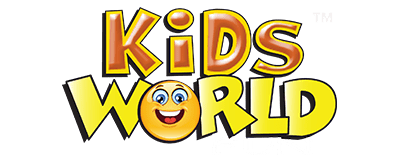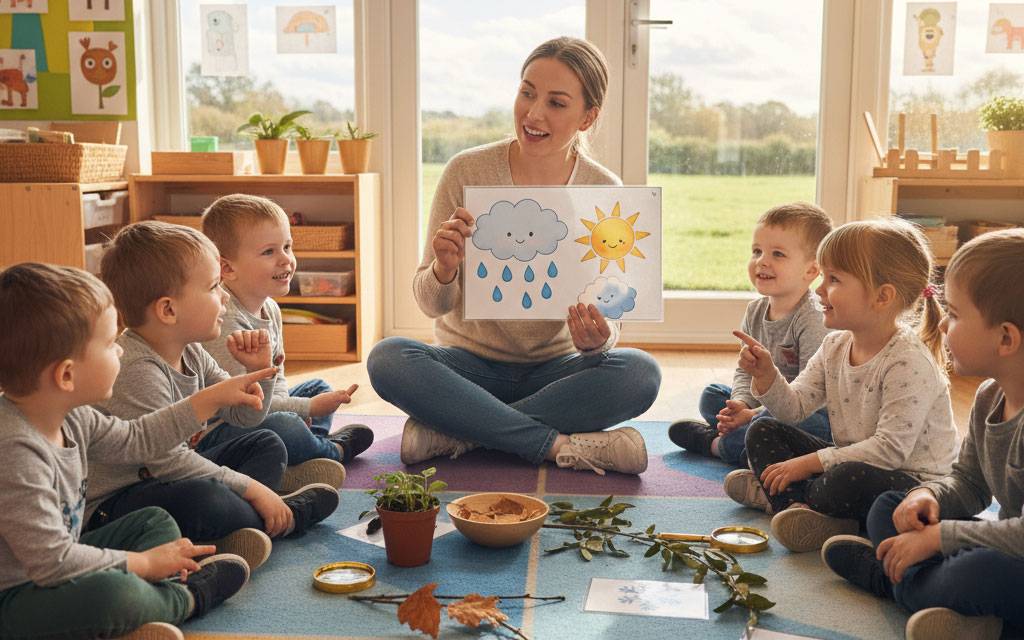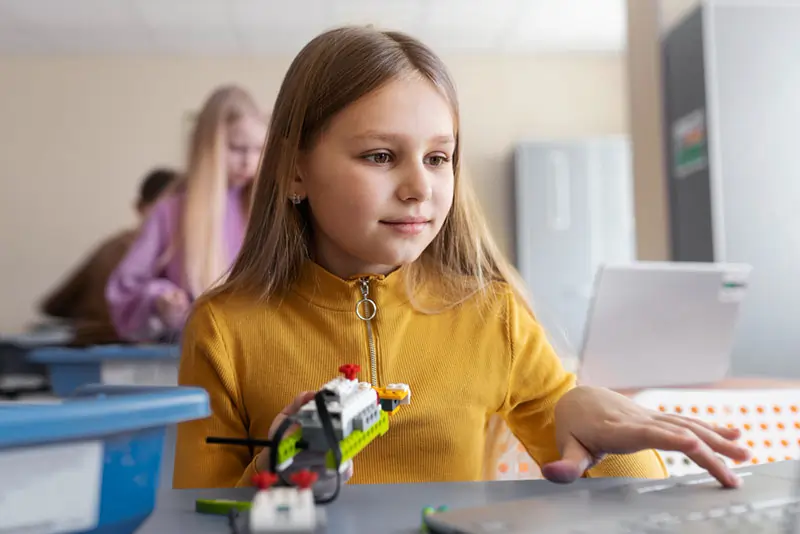Simple Science Lessons for Kindergarten: Learning About Nature and Weather
Getting to Know Environmental Awareness
Kids can learn, ask questions, and explore nature in a million different ways. For kindergarteners, doing hands-on activities to learn about the environment is a great way to get them interested in science for the rest of their lives. Kids are naturally curious about the world around them at this age. They want to know why leaves change color, where rain comes from, and what makes birds sing. Teachers and parents can use this natural curiosity to turn everyday things into science lessons that teach kids about the world around them and how to take care of it.
Science education for young children is more than just memorizing information. It helps kids learn to observe, think critically, and respect all living creatures. When kindergarteners do activities that let them explore nature, they learn about their senses, new words, and how things happen. These basic experiences get kids ready for more advanced scientific ideas in later grades and help them form an emotional bond with the environment that makes them want to protect and care for it.
Learning about plants, animals, and the seasons
The Seasons of the Year
Seasons are a great way to teach about patterns that repeat themselves in nature. Kindergarteners may see how the weather, the amount of daylight, and the plants change over the year:
| Season | Weather | Plants | Animals | Activities |
| Spring | Warmer, rainy | Flowers bloom, leaves grow | Birds return, babies born | Plant seeds, observe nests |
| Summer | Hot, sunny | Full growth, fruits appear | Very active, searching for food | Garden care, insect watching |
| Fall | Cooler, windy | Leaves change color, fall | Migrate or prepare for winter | Collect leaves, observe changes |
| Winter | Cold, possible snow | Many plants dormant | Hibernate or adapt | Track animal prints, feed birds |
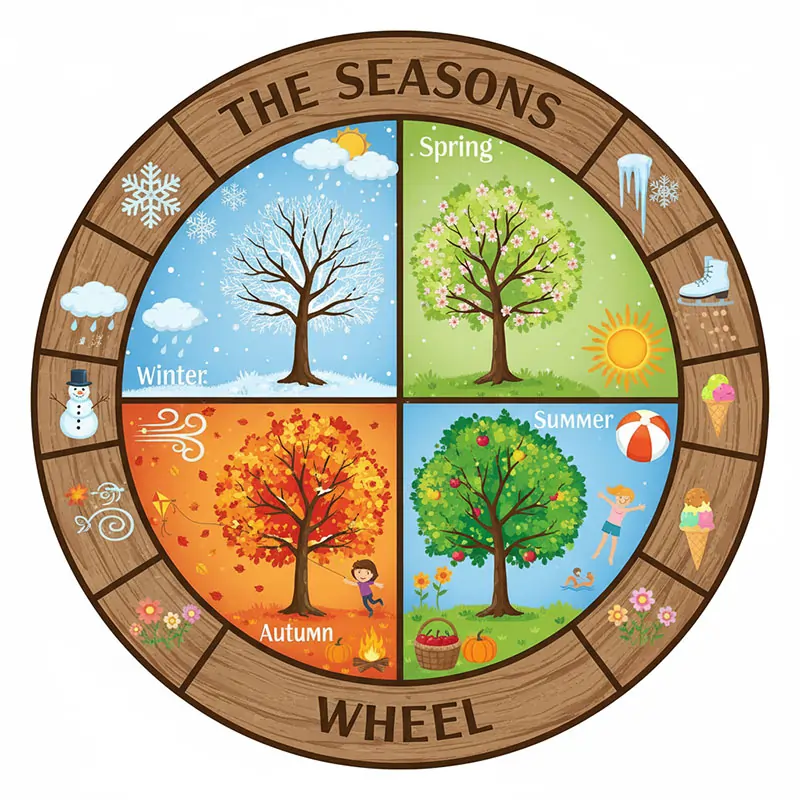
The Life Cycles of Plants
Teaching kids about plant structure and growth stages helps them comprehend how living things work. Some simple lessons could be:
- Parts of a plant: roots (take in water), stem (holds the plant up), leaves (create food), and flowers (produce seeds).
- What plants need: water, sunlight, air, and nutrients from the soil
- Stages of Growth: Seed → Sprout → Seedling → Mature Plant → Flowering → Seed →Production
Kindergarten science worksheets that ask kids to label sections of plants or put growth phases in order help them learn these ideas better by using pictures.
Animal Habitats and Behaviours
Kindergarteners can learn about where animals live and how they stay alive:
- Types of habitats: forests, oceans, deserts, grasslands, and polar regions
- Types of Animals: mammals, birds, reptiles, fish, and insects
- Ways to survive: hibernation, migration, disguise, and adaptability
Animals that are common and where they live
| Animal | Habitat | Special Feature |
| Squirrel | Trees (forest) | Stores food for winter |
| Fish | Water (pond, ocean) | Breathes through gills |
| Rabbit | Burrow (underground) | Long ears for hearing predators |
| Bird | Nest (trees, bushes) | Wings for flying |
| Frog | Near water | Lives on land and in water |
Activities for Watching the Weather
Weather gives scientists chances to observe things every day. Kids’ weather activities turn abstract ideas about the weather into real-life experiences.
Tracking the Weather Every Day
Make a weather station at home or in the school where kids can:
- 1.Look up at the sky. Is it sunny, cloudy, rainy, or snowy?
- 2.Check the temperature with a basic thermometer (with an adult’s aid).
- 3.Feel the Wind: Use flags or ribbons to tell which way the wind is blowing.
- 4.To measure rainfall, put a marked container outside when it rains.
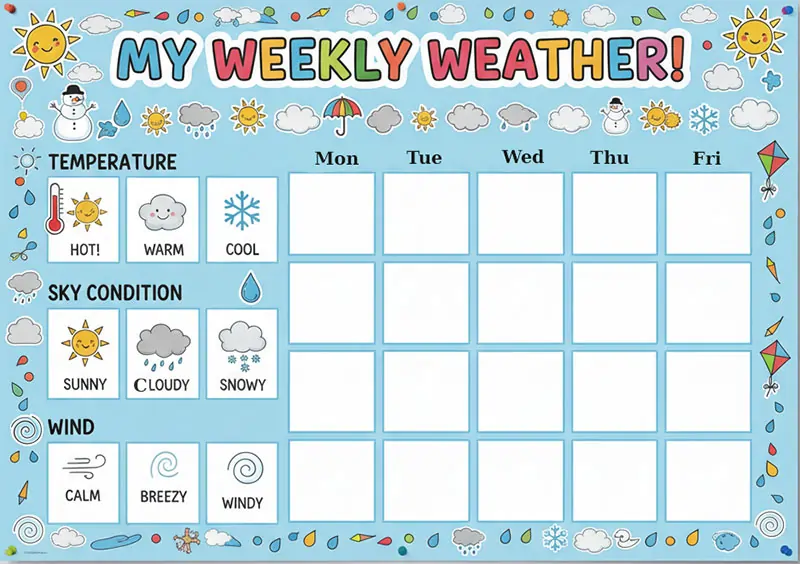
Building Vocabulary for Weather
Use weather words that are right for their age:
- Precipitation: rain, snow, sleet, and hail
- Types of clouds: fluffy (cumulus), wispy (cirrus), and gray rain clouds (nimbus)
- Temperature: Hot, warm, cool, and chilly
- Weather: windy, calm, humid, or foggy
Clothes and the Weather
Use matching games to help kids learn how the weather influences their daily lives. Make worksheets for children to draw lines between the weather and the right clothes:
- If it’s sunny, wear sunglasses, a hat, and a light shirt.
- Rainy day: boots, raincoat, and an umbrella
- On a snowy day, wear a warm jacket, gloves, and a winter cap.
- On a windy day, wear a windbreaker and a secure cap.
Worksheets for Classifying and Labeling
Structured exercise that helps kids learn by observing is what kindergarten science worksheets are all about. Worksheets that perform well for this age group should be visual, participatory, and doable.
Activities for Classification
Living vs. Non-Living Worksheet: Kids circle or color things that are alive (like plants and animals) and things that are not alive (such rocks, toys, and water). This basic difference helps them learn how living things work.
Traits of Living Things
| Living Things | Non-Living Things |
| Grow and change | Don’t grow |
| Need food/water/air | Don’t need nutrition |
| Reproduce | Don’t make babies |
| Respond to environment | Don’t respond |
| Examples: Trees, dogs, butterflies | Examples: Stones, toys, clouds |
Animal Sorting Worksheet Give kids pictures of different animals and have them sort them by:
- Where they reside (in the air, on land, or in the water)
- How they get around (walk, fly, swim, crawl)
- Covering the body (fur, feathers, scales, skin)
Labelling Activities
Plant Diagram Labeling: Draw a simple flower and use arrows to point to the roots, stem, leaves, petals, and flower. Kids can write or trace words, or they can match word cards to the right sections.
Make a worksheet with weather symbols (such a sun, cloud, raindrop, snowflake, and wind lines) and the words that go with them. Kids match symbols to words and color them in the right way.

Creative Projects: A Small Garden and a Chart for Rain
Hands-on projects make abstract ideas into unforgettable experiences that use more than one sense and way of learning.
Small Garden Project
Things You Need:
- Small pots or containers that have been used before
- Soil for pots
- Seeds that grow quickly, like beans, sunflowers, and herbs
- Source of water
- A sunny place
Step-by-Step:
- Preparation (Day 1): Kids paint pots, fill them with dirt, and sow seedlings.
- Daily Care: Water according to the instructions on the seed packet and put them in the sun.
- Observation: Every week, the kids sketch illustrations of how their plants are growing.
- Recording: Use a ruler to measure height, count leaves, and write down any changes.
Goals for Learning:
- Know what plants need (water, light, and soil)
- Take care of your things every day to learn responsibility
- Watch increase over time
- Write down scientific observations
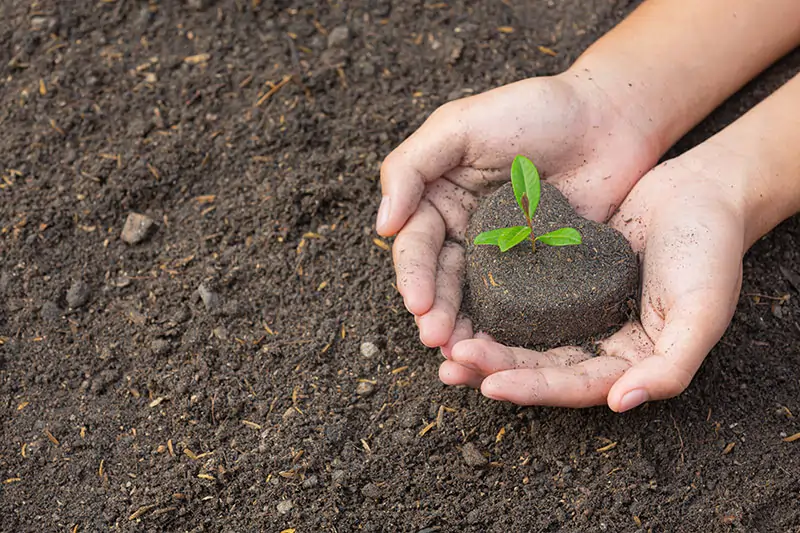
This project goes perfectly with a growth log worksheet where kids draw pictures and take simple measurements to keep track of how their plants are doing.
Project for the Rain Chart
Things You Need:
- A clear plastic box with straight sides
- A permanent marker or tape that won’t come off
- A ruler
- Sheet for recording
Putting it into action:
- Set up: Draw lines on the container to measure (1/2 inch, 1 inch, etc.)
- Placement: Put the container outside in an open location when it rains.
- Measurement: Kids look at the water level after it stops raining and write it down.
- Graphing: Put the measurements on a bar graph that shows how much rain fell during each storm.
Sample Data Collection for Rain Charts
| Date | Rainfall Amount | Weather Observations |
| March 5 | 1 inch | Light rain, cloudy all day |
| March 12 | ¼ inch | Brief shower in morning |
| March 18 | 2 inches | Heavy rain, thunderstorm |
| March 25 | ½ inch | Drizzle on and off |
Fostering Curiosity and Love for Nature
The main purpose of early scientific education is not just to teach kids facts; it’s also to help them develop a sense of awe, respect, and responsibility for the natural world.
Questions that make you think
Make a “Wonder Wall” where kids can write their questions about nature:
- “Why is the sky blue?”
- “Where do butterflies go to sleep?”
- “How do trees get so tall?”
Answer one question a week by doing basic experiments, reading books, or going on walks in nature.
Nature Walks and Outdoor Observation
Regular time spent outside gives kids chances to learn without structure:
Organized Nature Walk Activities:
- Scavenger Hunt: Look for things that are various colors, textures, or shapes.
- Sound Safari: Sit still and listen to natural sounds like birds, wind, and bugs.
- Texture Collection: Collect leaves, bark, and stones with varied textures in a safe way.
- Nature Journaling: Draw what you see, even simple forms and colors.
Becoming more responsible for the environment
Teach kids about conservation in a way that is right for their age:
- Don’t throw trash on the ground; keep outside areas clean.
- Don’t waste water: Turn off the taps when you’re not using them.
- Take care of living things: Be kind to animals and plants.
- Cut down on trash: Use what you already have for art projects.
Activity Idea: Make a chart in the classroom called “Earth Helpers” where kids can earn stickers for doing things that are good for the environment.
Results of Learning and Testing
Kindergarten science classes that work well teach kids how to do things instead than just memorizing facts.
What you should learn
By the completion of a unit on nature and weather, kindergarteners should be able to:
What you know:
- List the four seasons and what makes each one unique
- Name the main elements of a plant, such as the roots, stem, leaves, and bloom.
- Know the names of common animals and where they live
- List different kinds of weather
Skills:
- Use more than one sense to make observations
- Sort things based on things you can see
- Make drawings to record what you see
- Use easy instruments like a magnifying glass, a ruler, and a thermometer with help.
Attitudes:
- Show interest in the world around you
- Care about living things
- Show that you’re excited in exploring the outdoors
- Ask inquiries about things you’ve seen happen
Age-Appropriate Assessment Methods
Kindergarteners shouldn’t take traditional tests. Use this instead:
Observation checklists: keep track of how well each person is doing with certain abilities during activities (such participating in discussions, making observations, handling things safely, and following directions).
Portfolio Assessment: Collect work samples over time, such as finished worksheets, diary drawings, project images, and documented observations.
Conversation-Based Assessment: During activities, ask questions that don’t have a clear answer:
- “What do you see about…?”
- “What do you think?”
- “What could happen if…?”
Basic Assessment Rubric
| Skill | Developing | Progressing | Proficient |
| Observation | Notices obvious features | Notices some details | Notices multiple details |
| Classification | Groups with assistance | Groups by one attribute | Groups by multiple attributes |
| Recording | Random marks | Recognizable drawings | Detailed drawings with labels |
| Vocabulary | Uses 1-2 science terms | Uses 3-5 science terms | Uses 6+ science terms correctly |
Frequently Asked Questions
Q: How long should science lessons for kindergarteners last?
A: For direct instruction, keep lessons at 15–20 minutes, and for hands-on activities, keep them to 20–30 minutes. Because kindergarteners have short attention spans, it’s better to have a lot of short sessions than one long one.
Q: What do we do if we can’t get outside?
A: You may bring nature indoors by using potted plants, aquariums, terrariums, or even just things you find in nature. Add films and virtual field trips to your lessons. Watching the weather and birds from your windowsill can also help you learn.
Q: Are worksheets okay for kindergarten?
A: Yes, if utilized correctly. Science worksheets for kindergarten should be visual, including coloring or easy matching, and be used in addition to, not instead of, hands-on activities. Keep the time for worksheets to 10 to 15 minutes, and always talk about them afterward.
Q: How can I make lessons diverse for students with varied levels of ability?
A: Offer multi-level support: supply word banks for labeling, enable drawing instead of writing, pair students for peer support, and extend learning for advanced kids with “wonder questions” and further research opportunities.
Q: What safety issues should I keep in mind?
A: Always watch kids while they are outside, teach them not to try plants or berries they don’t know, show them how to handle live things gently, make sure they wash their hands after being outside, and check for allergies before starting any plant-related crafts.
Q: How can parents assist these lessons at home?
A: Talk about the weather every day, go on nature walks often, give kids magnifying glasses to use as they explore, read nature books together, and talk about how the seasons vary throughout everyday activities.
Conclusion and Free Science Printables
Science lessons for beginners that teach kindergarteners about nature and the weather lay the groundwork for scientific literacy and environmental awareness that will last a lifetime. We respect kids’ innate curiosity by integrating planned weather activities with open-ended environmental exploration. This helps them develop important skills in observation and classification.
This tutorial shows how to turn everyday things into fun learning experiences through hands-on crafts, worksheets, and time spent outside. Kindergarteners learn to think like scientists by asking questions, making predictions, and looking for answers through observation. They do this by recording rainfall, cultivating a seed, or just watching clouds.
Suggested free printables for science
To help you teach, think about making or getting these printables:
- Four Seasons Observation Journal: Each season has its own page with room to depict animals, plants, and weather.
- Weekly weather chart template with symbols and a place to write down the temperature
- Plant Growth Journal: Pages that go in order to record the growth of seeds into plants
- Animal Habitat Matching Game: Cards with pictures of animals and their dwellings
- Nature Scavenger Hunt Checklist: Things to look for while you’re outside
- Living and Non-Living Sorting Cards: Pictures to cut out and sort
- My Weather Book: Sentences containing weather words that you have to fill in the blanks
- Parts of a Plant Labeling Diagram: A big, clear picture with a word bank
These materials, along with daily observations and hands-on experiments, will help your kindergarteners build a lifelong love of science and environment. At this age, the process of finding out new things is more important than the knowledge learned. Every question asked, every leaf looked at, and every change in the weather observed helps people think scientifically in the future.
Enjoy the messiness of exploring mud, the unpredictability of the weather, and the amazement in children’s eyes when they see a seed blossoming or a butterfly landing. These times when we engage with nature are when true environmental stewardship starts. They are also where the scientists, conservationists, and informed citizens of the future are born.
With simple observations, an open mind, and printable tools that make learning about nature and weather easy, interesting, and exciting for all young learners, you can start your kindergarten science adventure today.
